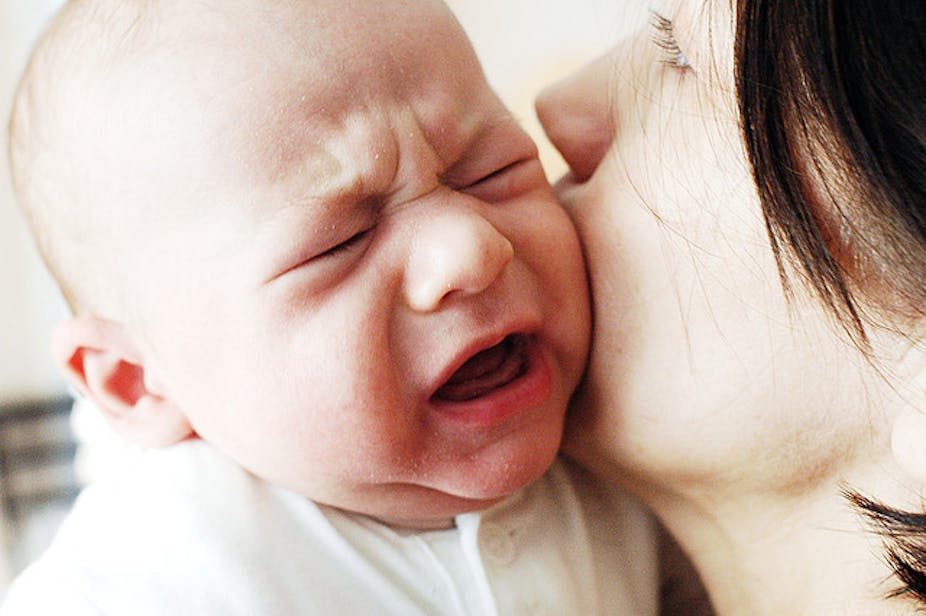In my clinical work with pregnant and postnatal mums experiencing anxiety and mood disorders, few issues are reported as consistently as sleep deprivation. Parents who spend the first year of their child’s life (or longer) waking up regularly throughout the night to attend to their child are, not surprisingly, at a higher risk for depression and anxiety.
It’s therefore understandable that parents want to know what can be done to help babies to sleep through the night. And with that interest comes strong opinions, best-selling books and even a “baby whisperer”, as it seems whispering is no longer just for horses.
In the midst of this clamour of advice is a good deal of controversy on a sleep technique for babies known as controlled crying. Advocates claim it saved their baby’s sleep and their sanity. Critics liken it to “normalised abuse” and claim it can cause lasting psychological damage.
We need to start where very few critiques on the topic have started – with a definition of what controlled crying is, and what it is not.
Controlled crying (also known as controlled comforting) is when parents respond to their infant’s cries and gently comfort them, then return at increasing time intervals to assist the infant to self-settle while knowing that the parent is still there. The key words there are respond and return.
The recommended implementation of such a technique is after six months of age. By Piaget’s theory of object permanence, this is the developmental stage when babies understand that an object (in this case the parent) still exists even when it is out of sight.

Controlled crying is not “extinction”. The extinction method is a dramatically-termed technique which refers to leaving a baby to “cry it out”. For example, when the infant cries at night, the parent shuts the door to the nursery and does not respond at all. The idea is that eventually the baby will understand that the parent is not returning and will self-settle.
In terms of controlled crying (not extinction), Australian researchers found that when mothers of infants aged six to 12 months used one of two interventions (controlled crying and “camping out”, where parents remain in the room while the infant returns to sleep before quietly leaving), not only was there a significant improvement in infants’ sleep, there was also a significant reduction in maternal depressive symptoms compared with controls.
The research team followed up these mothers and infants at the age of six years, and found no difference in emotional or behavioural problems, sleep problems, attachment, parenting styles or maternal mental health between intervention and control groups.
Despite it being clear that extinction techniques were not used in this study, there was considerable controversy about these findings. A letter to the British Medical Journal (BMJ) where the original paper was published even compared the study to research conducted in Nazi Germany under Hitler.
More recently, critics of controlled crying such as Pinky McKay and Margot Sunderland have drawn attention to the long-term ill effects of controlled crying. Ms McKay notes that babies who are left to cry are at risk of sensory deprivation and potentially long-lasting brain damage induced by early trauma, similar to what we know in psychological research as learned helplessness.
These critics are supported by a position paper against the use of controlled crying from the Australian Association for Infant Mental Health (AAIMH); however, this position paper has not been updated in almost ten years and explicitly notes that its reference list does not include any studies on the impact of controlled crying on infants.

The evidence from both animal and human studies is very clear that severe stress such as emotional neglect and abuse in infancy does indeed induce long-lasting changes in the developing brain. And I can see the link between extinction techniques and emotional neglect.
But it’s extreme to compare controlled crying, where the parent responds and returns, to emotional neglect such as that suffered by infants raised in Romanian orphanages. This confusion between extinction and controlled crying appears to be at the heart of the criticisms.
At the end of the day (literally), each family needs to work out what the best technique is to get their infant to sleep. Techniques such as controlled crying and camping out might help some families, but others will be very uncomfortable at the idea of not responding immediately to their infant.
Every baby is different, and suggesting there is one magic solution that will work for all babies, or that what worked for them will work for everyone, is not only misleading, but also confusing and distressing for mothers desperately seeking an answer and some sleep.
There’s a wealth of mums, whisperers, angels, and child health nurses out there - listen to their advice and work out the right solution for you and your family.

